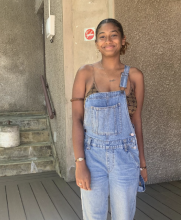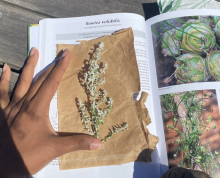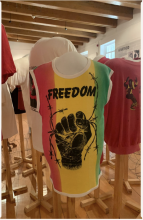My name is Sarafina Glaricia Lewis. I am a junior double majoring in Africana and Latin American studies and environmental studies. My namesake is from a famous movie from South Africa, centering on a young woman named Sarafina and other students fighting against apartheid. Sarafina! and other works by Steve Biko coupled with my personal experiences inspired me to know more about postapartheid South Africa; when I heard about a study group at the University of Cape Town, I immediately applied.
The required classes for this program were ALST 250 Representations of Africa with Professor Wilks and Biology/Physics 311: The Impact of Climate Change on Corals and Shells with Professor Metzler. In ALST we explored land in the colonial and postcolonial eras from different perspectives. I enjoyed deconstructing terms such as topography, a well-established study of the land that was created by missionaries to divide Africa. This course was also the first class in which I studied the colonial and postcolonial eras from the perspective of plants. Through Denisha Anand, we learned about the indigenous Khoi legend of Princess Vlei and what custodianship and indigenous practices can look like in marshlands. We discussed how enslaved African women brought rice, a seed that requires optimal conditions to grow, to the Americas during the Transatlantic slave trade.
We visited Happy by Nature, a garden and classroom where medicine men introduced us to medicinal plants such as cancer bush, or impepho. Finally, our class read about Rooibos tea, a plant with vitamins rich enough to substitute breast milk. Ironically, Afrikaaner farmers in the Western Cape claimed a deeper connection and superiority over the plant but used the labor and the knowledge of Black and colored people on plantations.
I appreciated Professor Metzler's ability to connect her field of study to land using methodologies that I learned in other ALST classes. For example, in her class, we discussed what constitutes a good conservation effort by reading, researching, and visiting different Marine Protected Areas (MPAs).
The course was designed to help students see how the planning of MPAs, similar to topography, did not include indigenous people or other community members living in the so-called “protected” areas. These lessons and realizations culminated in a semester-long project to construct a conservation proposal in an area we felt personally connected to. My project looked at how food apartheid in cities such as New York can be eradicated when a collective of urban gardens share their resources.
Beyond academics, South Africa–and Cape Town in particular–is a truly beautiful place. Between the buildings on campus was an area hidden by trees and vines where R&B or neo-soul music was playing in the background to many conversations. In this garden and throughout campus, I met so many wonderful people, even having beautiful conversations with the music librarian about her life and home garden.



